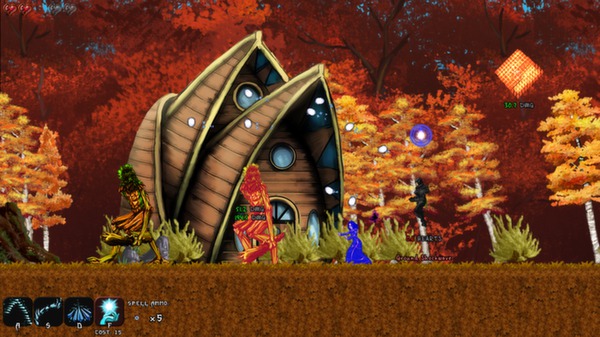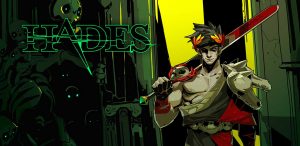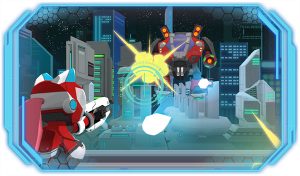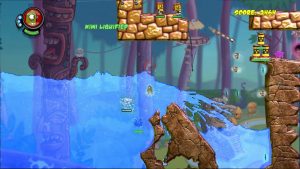I’ve always found developer interviews to be rather fascinating. A good developer interview can give us a better understanding of just what goes into the creation of the games we all enjoy. My first and only interview thus far was with a marketing manager from Privateer Press about Warmachine: Tactics, the video game adaptation of my preferred tabletop miniatures game. Honestly, it didn’t go quite as well as I hoped. Privateer Press and White Moon Dreams were being very secretive of the project, and as a fairly new journalist, I still wasn’t sure how to go about interviews. The game itself didn’t turn out all that great either. Still, I always wanted to do more interviews.
Developer Spotlight is my new attempt to both do more interviews and give some coverage to indie companies that I’ve taken a liking to over the years. This first article in what I hope to make a semi-regular series is all about Arcen Games, a small indie studio known for making some really odd strategy games. Arcen’s titles usually blend genres in interesting new ways, like a 4X with turn-based shooter combat (The Last Federation) or a procedurally-generated Metroidvania with town management elements (A Valley Without Wind).
But I’m starting to ramble here. I’ll just let Chris Park tell you all about the awesome games they make over at Arcen.
IGS: First, why don’t you start by introducing yourself and talking a little about Arcen Games and the company’s history.
Chris Park: I’m Chris Park, the founder and lead designer at Arcen. Back in the dark ages of 2009, I founded the company as kind of a side gig. I had been working in the business software realm for about 8 years at that point, but game design and coding had been a lifetime hobby of mine. It seems like an alien thought today, but when I was a kid — and even back as recently as 2009 — being a game developer for a living was not a reasonable prospect. You might get lucky and do it, but you’d probably have to move. You’d probably have bad pay, and horrendous hours, and not actually get to have much creative input. No thanks.
By sheer luck, Arcen came to life right around the start of the indie revolution. Our first game, AI War: Fleet Command, remains our most popular, best-selling, and best-reviewed. But we’re now 8 games and… I want to say 7 expansions… along now. We’ve experimented in a lot of genres, had financial ups and downs, had staff growth and shrinkages, and overall been on an upward trend each year despite the stress and occasional setbacks. Our most recent game, The Last Federation, got very positive reviews and is now our #2 bestseller, so that’s been a big boon for us.
At present there are five of us fulltime: myself on design, business, general producer duties, sound design, and programming; Keith LaMothe as our lead programmer; Pablo Vega as our ever-awesome composer; and Daniette “Blue” Wood and Cathrine Langwagen as our artists. Blue also takes on art director responsibilities, finding and coordinating the various independent contractor artists that we periodically work with. We then have a roster of part-timers, including Erik Johnson on PR and marketing, Josh Knapp on community management and support, and then a variety of musicians, writers, voice actors, and so on that we work with off and on.
It sounds more impressive than it is; we all work out of our homes, and we try to keep it to as few people as possible while still being able to get the work done. Still, it’s a long way away from where we started when it was just me doing everything except music, which was Pablo from the start.
IGS: As you yourself pointed out, AI War remains your most successful game and still gets regular updates and expansions. Why do you think this particular game caught on the way it did?
Chris Park: It was one of Metacritic’s top-rated PC games (across all genres) for 2009, and Rock Paper Shotgun just named it as one of their top strategy games of all time. To a very large extent it is frustrating not being able to top your debut title, I will say. And if I knew exactly why it resonated so strongly, you can bet I’d try to do that again and again.
All of Arcen’s games are experimental and blend the familiar and the novel to various degrees. They also blend genres to various degrees. AI War happened to hit the sweet spot, evidently, and it also filled a void in the RTS games market that no other game has really touched to this day.

The mechanics of AI War are really familiar to an RTS player, overall: you can just sit down and pretty much know how to play and move things around. Just like you can sit down with whatever FPS game, and pretty much have your bearings on the controls within minutes. But AI War really challenges things in terms of what you do with those controls: you have to advance against a far superior foe, taking territory and gaining power… but not taking so much territory that the AI enemy notices you too much and comes to smash you.
So that turns all the actual strategy portions of the game on its head. You are not in a zerg rush to capture resource points: your enemy already has them all. You are not trying to capture all the territory and “paint the map your color” to gradually win: at some point during that process, the AI will notice you enough that they crush you. These differences on the macro scale, plus a ton of smaller mechanics, make for an experience that is familiar mechanically, but which takes you into the territory of leading a guerrilla fighting force, which is exciting and new.
Oh, and of course the AI itself: it’s coded unlike any other in the genre, and so it does a lot of really interesting and surprising things. It uses a distributed intelligence and some flocking-like algorithms to make for a truly worthy foe.
IGS: I personally really enjoyed Bionic Dues and rank it as one of my favorite Arcen titles, which is why I’m a bit disappointed that it never received an expansion like many other games you’ve created. Are there any plans to revisit Bionic Dues at some point?
Chris Park: For Bionic Dues, that’s a tricky proposition. I definitely really love it also, and it was a blast to make. But it’s one of the games that, unfortunately, has not earned back the money that we spent making it. Out of all our games, only AI War (and expansions), Skyward Collapse (and expansion), and The Last Federation (and expansion) have earned back the money we spent making them.
That’s one of the risks of being really experimental with what we do, I suppose; we have a number of games that only caught on in a more niche way, that people would like to see more of but that aren’t financially viable for us. With Bionic, I would definitely like to revisit a lot of the ideas from it at some point in the future. The roguelike area interests me, and that sort of turn-based style in particular. I think I would do it really differently next time, just to have something fresh and that stands on its own, but I could definitely see a spiritual successor for that somewhere in the future.
The big killers for us with that game were, I think: 1) the name is a turnoff for people; 2) the screenshots are very, very dark, which is a turnoff when people first hit the steam page; 3) we failed to have a really concise, exciting pitch for why you should play that game compared to another roguelike. There are a lot of them. We see a lot of stats thanks to Steam and other partners, and we know for a fact that the name and icon were a big turnoff, because the clickthrough rate is unusually low for this game out of all ours. Then the quick bounce rate (glimpsing the screenshots, etc) is also unusually high.
So in revisiting the concepts that I really like about that game, I’d pick a better name, have much more bright and interesting screenshots, and figure out an added high-concept hook to pique people’s interest. With AI War, for instance, that simple hook is “some of the best AI you’ve ever seen.” That gets people to look further, and then they either like it or don’t. But when people don’t make it to that stage of looking further, which is what happened with Bionic Dues, that’s when you’ve got a really deadly problem in terms of having any sort of widespread success.
IGS: A Valley Without Wind has an interesting story attached to it. From what I’ve read, A Valley Without Wind 2 came about due to a combination of mixed reviews and the team’s own dissatisfaction with how some mechanics turned out, though feel free to correct me if I’m wrong there. This lead to the game being significantly overhauled and released as a free sequel to owners of the original. Could you talk a bit about the problems with the original and the decision to make so many drastic changes and give it away as a freebie to existing customers?
Chris Park: AVWW was a troubled project all along, in some respects. First off, it’s very ironic to note that the original game gets played about 5x more than the sequel, so there’s that. AVWW had a lot of pre-release buzz and excitement, but I was still finding my legs as a designer in some ways, and I really made a number of missteps in the cohesiveness of the game. Some of the parts don’t fit together as much as I would have wanted. AI War was a mix of genres: grand strategy, RTS, 4X, and even tower defense. But AVWW mixed citybuilding with a Metroidvania action-platformer, and that was less snug of a fit.

One of the biggest complaints against the first game, at least in terms of frequency, was the art. People didn’t like the art. (Then of course, after the second one came out, a bunch of people started talking about how they actually did like the art of the first one, sigh). So I wanted to embark on an upgrade to the art, which would be free to all existing customers. But during that process I realized that I wanted to change more than just the art if we were already spending all that effort and money making new art. Why not avoid a plain reskin, and instead focus on fixing things that I was annoyed with in the first game
The problem was, I’d already promised the art upgrade for free to the customers of the first game, and they were excited about it. What was I going to say: “sorry I promised you this one thing, but that’s canceled and now I’m going to charge you for this other thing!” That didn’t sit right with me, although we were having financial difficulties at the time and ultimately that wound up costing me a couple of hundred thousand dollars in losses. (Yow. It’s lucky AI War did so well, or the company would have sunk around then.)
Valley 2 was an interesting game in that it reigned in some of the things that I felt like were over-complicating the first one, including the crafting and equipment systems, and it completely revised how the procedural world generation worked. Out of the two games this is probably the one I prefer, although I personally like them both. The press preferred this one by a large margin, but players prefer the first one by a huge margin. The sequel isn’t even in the same genres as the first one, incidentally: it’s a Contra-like instead of a Metroidvania, and rather than having a city-building component it instead has a strategic layer.
The mix of strategy and Contra-like is a tricky thing, because the set of people who like A and B is a very tiny portion of the sets of people who like A or B. Even so, had that game been sold as a standalone game, I think that we would have broken even on the two games, which is some comfort to me. I wasn’t so off the mark that they would have been a huge loss or something, aside from the fact that I gave the sequel away for free. And I don’t regret that decision either, despite all the trouble it’s caused financially; it was the right thing to do, for one, and goodwill is simply worth more, for two. Even from a selfish capitalist standpoint, I think that sort of decision makes sense in the long term.

Anyway, the second game was a lot more polished and cohesive, but still two very disparate genres. The first one was much rougher and not as pretty, but there is also just something… elementally fun about it. There’s an X-factor there that gets somewhat lost in the sequel.
IGS: On a somewhat related note, if you could revisit a previous game and create new content, expansions, or even a full sequel, which game would it be and why?
Chris Park: Honestly the thing I keep coming back to in my head over and over again for the last couple of years is “what if I did a sequel remake of AI War?” Basically take the base game of AI War plus all the content of its expansions, do new art, and make a bunch of revisions to smooth out some of the rougher elements there. The learning curve on that game is steep, the interface is something I’d like to experiment with a lot, the tactical AI is something I’d like to experiment with more, and I’d like to figure out some way to handle the combat that doesn’t so routinely have thousands of ships vs thousands of ships (that can eat weaker CPUs).
But then I always think about Valley 2. If that game had been a standalone thing, and not the sequel to Valley 1, then I think that game would have been received by players. There would have been no expectations that “okay, this is Valley 1 again, just prettier… and different but not too different.” That sort of expectation can be deadly when you’re really trying to reinvent something. Somehow Nintendo makes that work again and again, but then you see games like Supreme Commander 1 vs SupCom 2 where those really fall flat.
I think, for those reasons, if I ever did a “sequel” to AI War, I’d call it something else, distance it from the original in a number of ways, and just make it the semi-spiritual successor. Then again, that doesn’t really work. People still always gripe about how spiritual successors to System Shock 2 don’t live up to that one. Or Tim Shafer and anything since Day of the Tentacle or maybe Secret of Monkey Island. Just because it’s him and it’s an adventure game, there are certain expectations. Those thoughts really make me wary of revisiting the past too much.
IGS: Why don’t you tell us a bit about your upcoming game, Stars Beyond Reach, and what gamers can expect when it releases in September.
Chris Park: This is Arcen’s first true 4X title, and it mixes in a healthy dose of city-building in a really complementary way. In a lot of ways you can think of it like Civilization meets SimCity, but with a whole lot of unique elements as well. Like AI War, this one is sandboxy in terms of how you go about moving from start to victory, and this also moves along at a pretty quick pace once you know the generalities of what you’re doing.
One of my favorite elements of this game, though, is that it really has a lot of good opportunities for Dwarf Fortress-style LPs. Boatmurdered is something I just love, and having a game that’s rich enough in content and gameplay to evoke those sorts of twisting and darkly hilarious tales of woe is something that has always interested me.
This is our biggest game yet by far at this point, which is exciting. It’s our prettiest, and in a lot of ways I think it will be our most polished. My dear hope is that this will finally be something that can top AI War, but it’s not there yet. It’s already a great game and there are a couple more months to go, so hopefully we’ll be able to push it over the top between now and release. Whether or not it tops AI War, though, this is one that I’m definitely exceptionally proud of.
IGS: Thanks for your time and good luck with your future games.
If you want to check out Arcen’s games for yourself, you can find them on Steam, GOG, and Humble Store.
Frank is an aspiring game designer that currently writes for Indie Game Source and Bell of Lost Souls. You can follow him on Twitter @Frank_Gaming for updates on future articles and reviews.



